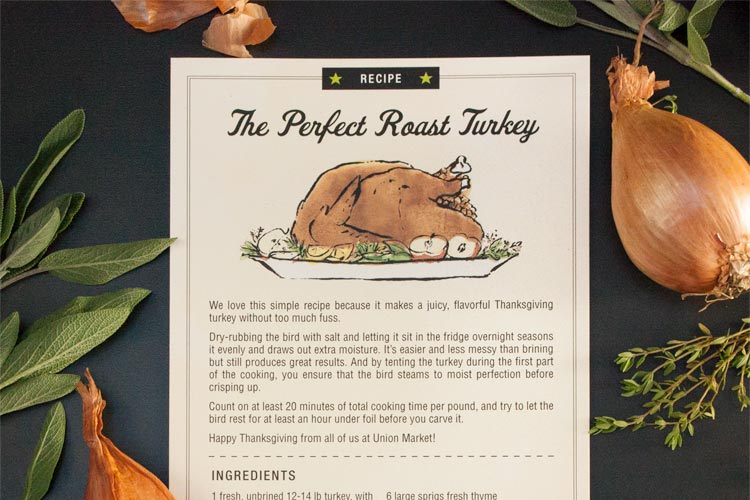THANKSGIVING TURKEY
INGREDIENTS
1 fresh, unbrined 12-14 lb turkey, with neck and giblets for gravy
1 stick unsalted butter, softened
½ lb carrots, washed and scrubbed and cut into large chunks
1 large onion, peeled and chopped into large chunks
4 stalks celery, with leaves, chopped into large chunks
4 cloves garlic, peeled
6 large sprigs fresh thyme
4 large sprigs sage
Freshly ground pepper to taste
Kosher salt
4-8 cups low-sodium chicken stock
2 tsp cornstarch dissolved in 2 tsp water
1 cup dry white wine
PREPARATION
At least 24 hours before you plan to roast your turkey, rinse it with cold water and pat dry. Rub thoroughly inside and out with salt. Use approximately ½ tsp per pound, so 6-7 tsp for a 12 lb bird. If you want to make carving the bird easier, remove the wishbone by cutting a narrow slash along both sides of the wishbone with a small knife, and then use your thumb and forefinger to gently tug it out.
Leave the turkey to air-dry on a pan in the refrigerator for 24-48 hours.
ROASTING
Remove the turkey from the refrigerator 2 hours before you plan on roasting, letting it come up to room temperature.
Preheat the oven to 375°F.
Fold the wings behind the bird’s back. Rub the softened butter over the breast of the turkey and under the skin.
Put the vegetables, half of the herbs, giblets, and neck in the bottom of a deep roasting pan. Season with salt and pepper and cover with a ½ inch of stock.
Put the other half of the herbs in the cavity. Place the turkey on a roasting rack and then place in the pan on top of the vegetables.
Carefully tent the pan with two long sheets of aluminum foil, making sure that the foil doesn’t touch the turkey, and that it’s crimped tight onto the edges of the pan.
Cook undisturbed for 2 hours for a 12-14 lb turkey. Add 20 minutes more per pound for turkeys larger than 14 lb.
Take the pan out of the oven. Remove the foil tent and keep aside. Baste the breast of the turkey with the pan juices—add up to a cup of stock if it looks like it’s low.
Place back in the oven, uncovered. Check the bird every half hour, remembering to baste it each time. To check for doneness, insert an instant-read thermometer into the thickest part of the thigh—it should read 165°F when the turkey is done.
Once the turkey is done, carefully remove to a carving board and tent with foil. Let it rest for at least an hour before carving.
GRAVY
Meanwhile, heat the roasting pan on a burner over high heat until the remaining stock starts to boil. To deglaze the pan, add the wine and scrape up all of the brown bits from the bottom of the pan. Let it continue to cook for a minute or two over high heat.
Strain the stock from the roasting pan into a deep saucepan and let sit for 15 minutes. Remove any fat from the surface using a ladle and then measure the remaining stock. Add enough fresh stock to make as much gravy as desired, as much as 8 cups of gravy in total.
Set on high heat until the stock has reduced by half, to form a thin but flavorful jus. Add the cornstarch mixture slowly, whisking as you do. Bring it back to a boil, stirring occasionally, until the mixture thickens and becomes glossy. Remember to only adjust the salt at the end!


